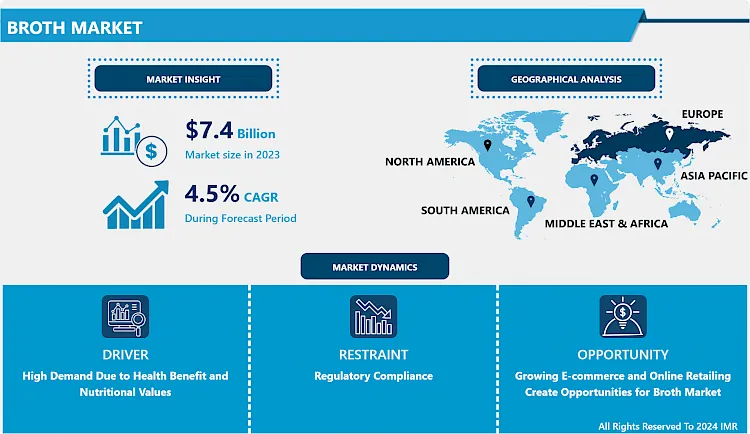Broth Market Synopsis
Broth Market Size Was Valued at USD 7.4 Billion in 2023, and is Projected to Reach USD 11.08 Billion by 2032, Growing at a CAGR of 4.5% From 2024-2032.
The broth is referred to as the liquid, which is produced by mixing simmered meat or vegetables in it. It is thick in texture and is utilized as an important substance in the preparation of various dishes. Broth consists of various flavors and thus enriches the taste of dishes in which it is being used. These flavors come from aromatic vegetables, herbs, and spices. In addition, it does not get chilled when refrigerated, which makes it available to be used even after a few days.
- As the broth is seasoned and salted, it is even compared to be a dish. Bone broth is a soupy composition of bone and bone cartilage of chicken or beef. Bone broth is consumed owing to its numerous nutritional compositions and its rich protein content. The bone broth is slow cooked for more than half a day to form a uniform broth and its taste is received over the globe.
- There is a growing awareness of the health benefits associated with consuming broth. Broths, especially those made from bones, are rich in essential nutrients such as collagen, amino acids, and minerals. These nutrients are believed to contribute to improved joint health, gut function, and overall well-being. As more consumers prioritize health and wellness, they are turning to nutrient-dense foods like broth to support their dietary goals.
- Moreover, the popularity of various diets, such as paleo and keto, has contributed to the surge in demand for broth. Broths are often considered compatible with these diets due to their high protein content and low carbohydrate levels. Additionally, broth is frequently used as a base for soups and stews, making it a versatile and convenient choice for those following specific dietary plans.
- The culinary world's increased focus on traditional cooking methods and artisanal products has also propelled the broth market forward. Consumers are becoming more interested in authentic, slow-cooked, and flavorful foods, and broth fits perfectly into this trend. Artisanal broth producers, often using high-quality, locally sourced ingredients, have gained popularity as consumers seek out products with a focus on craftsmanship and authenticity.


Broth Market Trend Analysis
High Demand Due to Health Benefit and Nutritional Values
- The broth market has experienced a significant surge in demand attributed to the increasing awareness and emphasis on health benefits and nutritional values associated with broth consumption. As consumers become more health-conscious and seek wholesome, nutrient-dense food options, broths have emerged as a popular choice due to their numerous health benefits. ?
- Broths, whether made from bone, vegetables, or other ingredients, are known to be packed with essential nutrients such as vitamins, minerals, and amino acids. Bone broth, in particular, is prized for its collagen content, which supports joint health, skin elasticity, and overall well-being. These nutritional properties have positioned broths as a functional food, appealing to a diverse consumer base looking to enhance their diet with natural, nutrient-packed options. ?
- The rise of wellness trends and the increasing adoption of holistic approaches to health have further fueled the growth of the broth market. Consumers are seeking products that not only satisfy their taste buds but also contribute positively to their overall health. Broths are often perceived as a convenient and versatile way to incorporate beneficial nutrients into daily diets, making them a go-to choose for health-conscious individuals. ?
- Moreover, the demand for broths has been bolstered by the growing popularity of specialized diets such as paleo, keto, and gut-friendly regimens. Broths align well with these dietary preferences, as they are often low in carbs, high in protein, and supportive of gut health. As more people embrace these lifestyle choices, the broth market continues to expand to meet the evolving needs of discerning consumers.
Growing E-commerce and Online Retailing Create Opportunities for Broth Market
- One of the primary advantages of entering the e-commerce space is the potential to reach a global audience. Online retailing eliminates geographical limitations, allowing broth producers to connect with customers beyond their local markets. This expanded reach opens up new avenues for sales and brand recognition, enabling broth manufacturers to target diverse consumer preferences and dietary trends.
- Furthermore, the convenience factor plays a crucial role in the success of online retailing for broth. Consumers can browse through a variety of broth products, compare prices, and read reviews from the comfort of their homes. This accessibility encourages impulse purchases and facilitates the exploration of new and niche broth products. With the convenience of doorstep delivery, customers are more likely to make repeat purchases, contributing to brand loyalty.
- E-commerce platforms also provide a space for targeted marketing and personalized recommendations. Broth producers can utilize data analytics to understand consumer behavior, preferences, and purchase patterns. This valuable information allows for the creation of targeted marketing campaigns, promotions, and product bundles, tailoring the online shopping experience to individual tastes.
Broth Market Segment Analysis:
Broth Market Segmented on the basis of type, nature, and distribution channel.
By Type, Vegetables Broth segment is expected to dominate the market during the forecast period
- Health and wellness trends play a pivotal role in driving the popularity of Vegetable Broth. Consumers are becoming increasingly aware of the importance of a balanced diet and are seeking products that contribute to their overall well-being. Vegetable broths, rich in vitamins, minerals, and antioxidants derived from various vegetables, align with these health-conscious consumer choices. Additionally, vegetable broths are often perceived as lower in calories and fat, making them an appealing option for those looking to manage their weight and maintain a healthy lifestyle.
By Nature, Organic segment held the largest share of 35% in 2022
- The growing awareness of health and wellness has spurred a demand for organic products. Consumers are becoming more discerning about the quality of ingredients in their food, opting for products that are free from synthetic chemicals, pesticides, and genetically modified organisms (GMOs). Organic broths, made from ingredients cultivated without the use of synthetic pesticides or fertilizers, resonate with individuals seeking a clean and wholesome diet.
Broth Market Regional Insights:
Europe is Expected to Dominate the Market Over the Forecast period
- The Europe region for broth market is witnessing growth and dominates the market due to the presence of leading key players such as Bare Bone Broth Company, Paleo Broth Company, and others in this region. the growing interest in alternative diets, such as paleo and keto, has boosted the demand for broth in Europe. Broths, particularly bone broths, align with these dietary preferences as they are low in carbohydrates and can be included in various recipes suitable for these lifestyles. The versatility of broths as a base for soups, stews, and other dishes appeals to consumers looking for nutritious and convenient meal options.
- The culinary landscape in Europe is also witnessing a revival of traditional cooking practices, with broth playing a central role in many classic recipes. The appreciation for artisanal and homemade food has led to an increased interest in preparing broths from scratch.
Broth Market Top Key Players:
- Campbell Soup Company (USA)
- Pacific Coast Producers (USA)
- Kettle & Fire (USA)
- Maruchan Inc. (USA)
- Hain Celestial Group, Inc. (USA)
- Kraft Heinz Company (USA)
- McCormick & Company, Inc. (USA)
- Blue Diamond Growers (USA)
- Unilever (Netherlands)
- Nestlé(Switzerland)
- Ajinomoto Co., Inc. (Japan)
- Kewpie Corporation (Japan)
- Premier Foods Group (UK)
- Meiji Holdings Co., Ltd. (Japan)
- Edward & Sons Trading Company (Japan)
- Masan Group Corporation (Vietnam)
- Kikkoman Corporation (Japan)
- Paleo Broth Company (UK)
- Bonafide Broths (Australia)
- Kettle Cuisine Ltd. (UK) and Other Major Players
Key Industry Developments in the Broth Market:
In January 2023 - Campbell Soup Company Launched its "Plant-Powered Broths" featuring three organic, plant-based broths made with vegetables, herbs, and spices. This caters to the growing demand for vegan and plant-based options.
In April 2023 - Pacific Foods Introduced its "Organic Creamy Coconut Broth" in offering a dairy-free and flavorful alternative for soups, curries, and stews. This taps into the popularity of coconut-based products and ethnic flavors.
|
Broth Market |
|||
|
Base Year: |
2023 |
Forecast Period: |
2024-2032 |
|
Historical Data: |
2017 to 2023 |
Market Size in 2023: |
USD 7.4 Bn. |
|
Forecast Period 2024-32 CAGR: |
4.5 % |
Market Size in 2032: |
USD 11.08 Bn. |
|
Segments Covered: |
By Type |
|
|
|
By Nature |
|
||
|
By Distribution Channel |
|
||
|
By Region |
|
||
|
Key Market Drivers: |
|
||
|
Key Market Restraints: |
|
||
|
Key Opportunities: |
|
||
|
Companies Covered in the report: |
|
||
|
Broth Market |
|||
|
Base Year: |
2023 |
Forecast Period: |
2024-2032 |
|
Historical Data: |
2017 to 2023 |
Market Size in 2023: |
USD 7.4 Bn. |
|
Forecast Period 2024-32 CAGR: |
4.5 % |
Market Size in 2032: |
USD 11.08 Bn. |
|
Segments Covered: |
By Type |
|
|
|
By Nature |
|
||
|
By Distribution Channel |
|
||
|
By Region |
|
||
|
Key Market Drivers: |
|
||
|
Key Market Restraints: |
|
||
|
Key Opportunities: |
|
||
|
Companies Covered in the report: |
|
||








